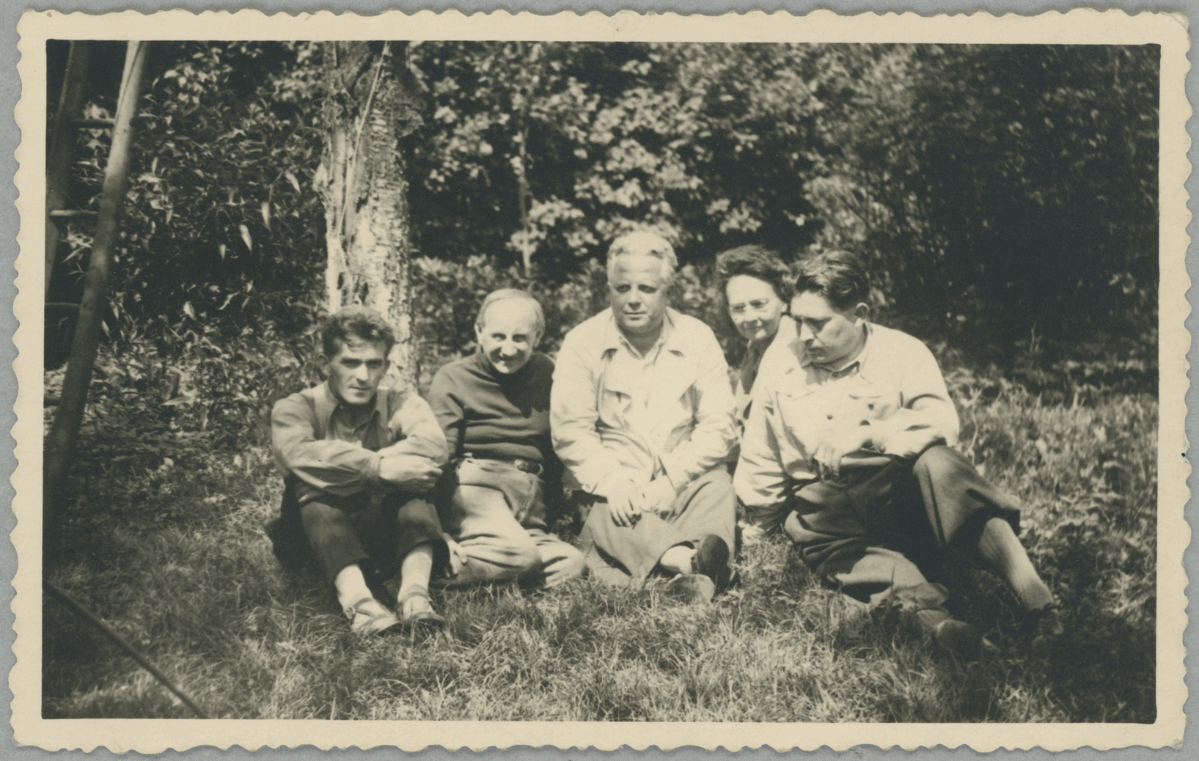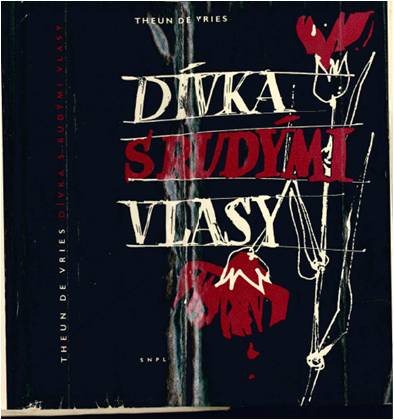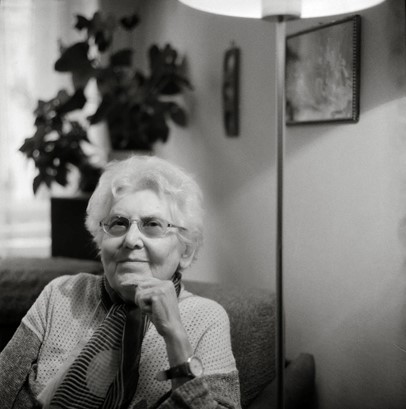The three good fairies of Dutch
Lída Faltová, Ella Kazdová and Olga Krijtová
The number of translations from Dutch into Czech rose sharply in the early 1930s. This was joined with the start of the translation career of a young woman from the little South Moravian village of Žerůtky. She was the first of three important female translators who together would provide a very large part of the translations from Dutch in the period 1932-2007: Lída Faltová (1890-1944), Ella Kazdová (1909-1982) and Olga Krijtová (1931-2013).
Lída Faltová

The Czech translation of Elsschot's novels Tsjip and Kaas (Praha, 1936), the latter being the first translation of the novel worldwide
Lída Faltová was born on 26 September 1890 as Ludmila Pospíšilová. She went in 1904-1910 to the secondary school at one of the first girls’ gymnasia in the country, Vesna in Brno. Afterwards she studied French at the in 1919 newly founded Masaryk University in Brno. There she met in the circle around the poet, writer and dramaturg Jiří Mahen the five years younger Josef Falta (1895-1973), a journalist of the social-democratic newspaper Právo lidu [Right of the People]. The couple married in 1923 and moved to Prague, where Falta became in 1935 a secretary of František Soukup (1871-1940), president of the Senate of the Czechoslovak Parliament.
Faltová started to translate from French but became somehow interested in Dutch literature. In 1928, she translated Een zwerver verliefd [The Love-Struck Tramp] of Arthur van Schendel and sent her translation to the cooperative publisher Družstevní práce [Cooperative Labour]. The translation was not published due to financial issues but the attention of the publisher was awaked. In 1932 DP commissioned the translation of Multatuli's Woutertje Pieterse to her. It was the begin of a fruitful cooperation of Faltová with three major publishers – DP, Melantrich and ELK (an imprint of Sfinx). She translated until 1944 the number of 38 published titles for Dutch, the most successful item was De scheepsjongens van Bontekoe [Java ho! The Adventures of Four Boys amid Fire, Storm and Shipwreck] that was till 2010 eight times reprinted with a total print run of three quarters of a million pieces. From the view of Dutch literature is interesting that she made in 1936 the historically first translation of Willem Elsschot’s famous novel Kaas [Cheese]. Next to these she commissioned in the 1940s five other translations that due to the Nazi censorship couldn’t be published. Several of her translations were published posthumously after liberation in the late 1940s.

From left to right: the poet Klement Bochořák, publisher Břetislav Klika (DP), poet František Halas, Lía Faltová and the writer and later Nobel prize laureate Jaroslav Seifert (Kunštát, 19 July 1940)
Her last years were not very agreeable. After the Sudeten crisis, her husband fled through Poland and Sweden to the United States, she stayed with their son Stanislav (1932-1952) in the Protectorate, notwithstanding attempts of ‘her’ Dutch writers to organise a visa for the Netherlands. When in 1941 Stanislav was arrested by the Gestapo immediately after the final examination of his secondary school, Faltová got serious thyroidproblems that finally asued her death on 8 December 1944. She died when she was working on the translation of Erik of het klein insectenboek [Eric in the Lands of the Insects] by Godfried Bomans. The important Czech-German translator and literary critic Pavel Eisner wrote in his in memoriam in May 1945:
Not just the gap from that banal phrase remains, but really a gaping hole. And that alone because, in general, we already have a catastrophic shortage of really good translators. In Lída Faltová's case, there is also the fact that she was just about the only one in the category of the most valuable Dutch-Flemish translation. The question – who would take her place? – we do not need to ask because it is pointless. Seek, seek – ye shall not find, at least for the time being. (Eisner, 1945, 6)
Several of her translations were still reprinted at the end of the twentieth century.
Ella Kazdová

Nevertheless there was a young woman able and willing to fill up the ‘gaping hole’ left after Faltová’s decease. In the Central Bohemian city of Kladno, a little girl Gabriela was born on 1 December 1909 in the family of František and Luise Hanka-Kučera, both being among the first Czech cinema actors. Although Gabriela acted in silent movies as a young girl, she chose a completely different career path and in 1928, after her final exams, went to work for the press service of the Czechoslovak Ministry of Foreign Affairs. In 1929-1934, she was sent to the Czechoslovak legacy in The Hague, where she learnt fluently Dutch. After her return she took her final exams in Dutch at Charles University in Prague in 1935, became a court interpreter and married the engineer and urban planner Jaromír Kazda (1894-1973), with whom she had a son in 1948.
In 1947, she was commissioned with the translation of Bomans' Eric in the Land of the Insects, that was left unfinished due to Faltová’s decease. This book was to become her first literary translation from Dutch, although it was never published (Leersum, 1993). In the years 1947-1948, she translated several books, but after the Communist take-over, the family got into trouble. Her husband was imprisoned in the Stalinist period 1950-1953 for 'anti-Communist activities', and she herself was forbidden to publish. Although her husband was rehabilitated in the late 1950s, Kazdová was dismissed from the court as an interpreter in 1960. From 1964 until her retirement in 1969, she worked at the Prague Institute of Haematology. Besides many medical texts that she had to translate for her work, she also remained active in the literary field, so that from 1958 until her death on 13 January 1982 Kazdová was the main translator from Dutch of the Catholic publishing house Vyšehrad.
Kazdová preferred the light genre, among the some 20 books she translated were Eiland der demonen [Demons on Bali] by Johan Fabricius, her first published translation, Het verjaagde water [Roll back the Sea] by A. den Doolaard and several novels by the rural Flemish writer Fred Germonprez. In 1974 she was awarded a prize by the Belgian Ministry of Education and Culture for her literary work in translating Flemish authors. Kazdová led an intensive correspondence with some of her authors, especially Antoon Coolen and Anne de Vries.
Olga Krijtová

Dusk jacket of the 1959 edition of Dívka s rudými vlasy, the Czech translation of Het meisje met het rode haar
By far the most important of the three translators was Olga Krijtová. She was born on 30 March 1931 in the family of the physician Alexander Fuchs and she spent most of her childhood in Nymburk, a little town that was said to be founded by Dutch settlers. Because of her very poor eyesight, she was not admitted to art school and decided to study in 1950-1955 the language of her beloved Dutch painters as a second best. This turned out to be a great success. When she married the Dutch emigrant Hans Krijt (1927-2011) in 1956, she came into direct contact with Dutch writers through his acquaintances, including Theun de Vries, who contributed many books to her. In the meantime, she became a lecturer of Dutch at her alma mater and in 1958 her first translation, of De onrustzaaier [The Troublemaker] by Willem van Maanen was published in the periodical Světová literatura [World Literature]. More than 80 translations would follow.
In the 1950s and 1960s, Krijtová focused mainly on narrators like Arthur van Schendel, whose Fregatschip Johanna Maria [The Johanna Maria] she translated, or her friend Theun de Vries of whom she translated several novels, i.a. the famous Het meisje met het rode haar [The Girl with the Red Hair]. Writers with a more high-brow character, like Jan Wolkers, received through her translations in Světová literatura. Readability for the Czech reader was her priority or, as she remarked herself:
All these considerations, the desperate plea for the right to choose what is and is not suitable for translation, were nothing but an oratio pro domo, a self-defence by a translator with a mouse discipline – see the letter to Jan Wolkers – who was busy forming a peculiar canon, also for later generations (quoted in Krol 2015, 165).
In 1969, she received in the Netherlands the Dutch Nijhoff Award, an important award for translators. Because she had resigned her party membership out of indignation over the brutal termination of the Prague Spring, Krijtová was banned from publishing in the 1970s. Her translations could still be published – there was no one else who could translate so beautifully from Dutch – but they were published anonymously or under a different name. In this period, she turned toward classic writers such as Louis Couperus and Willem Elsschot but translated many children’s books as well. In the 1980s, the ban was lifted and Krijtová could translate modern works such as De aanslag [The Assault] of Harry Mulisch.

After the Velvet Revolution of 1989, Krijtová could finally defend her habilitation thesis and she was appointed associate professor. In 1994, she received for her translations and for her work as an academic the high royal distinction of Officer in the Order of Orange-Nassau. Even where she could retire in 1996, Krijtová stayed till 2001 an active academic at Charles University, and she kept on translating. Her 2005 translation of the novel De geruchten [The Fames] by the famous Flemish writer Hugo Claus was awarded the high Magnesia Litera prize. The last of her more than 80 translations was in 2007 Mijn soevereine liefde [My Sovereign Love] of Thomas Lieske. When her husband died on 12 March 2011, her time was up as well. She was honoured at the end of that year at Charles University with her 80th birthday, the last time she was on academic soil. On 7 November 2013, the grand old lady of Czechoslovak Dutch Studies deceased. It was the great pleasure of her last years that her former students continued her translation work and that there are now an average of 10-15 translations from Dutch into Czech per year.
References
Eisner, Pavel (1945).”Za Lídu Faltovou.” Panorama 21 (1), pp. 6-7.
Engelbrecht, Wilken (2021). Van Siska van Rosemael tot Max Havelaar. Nederlandstalige literatuur in Tsjechische vertaling tussen 1848 en 1948. Gent: Academia Press, pp. 164-171 (Faltová) and 253-254 (Kazdová).
(ed.) Hrnčířová, Zdenka (2001). En niemand zo aardig als zij... Opstellen voor Olga Krijtová. Praag: Universitaire Pers.
(ed.) Krol, Ellen & Lucie Sedláčková (2011). Olga Krijtová. Geschrift eener bejaarde vrouw uit 1997. Praag: Universitaire Pers.
Leersum, Wout van (1993-1995). “Perikelen rond de Tsjechische Erik.” Godfried 15, pp. 4-16; 16, pp. 26-32 and 17, pp. 29-32.
